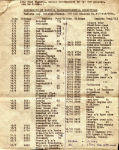| |||||||||
The
journey -
13 months 20 countries 30,000 land miles 16,000 sea miles | |||||||||
The
route | |||||||||
| Bristol
to Bombay [now Mumbai] in 6 weeks on roads of quality extremes. August 31st We left Bristol with an official police motorbike escort. Malcolm who was standing in the lead car lost his hat in the slipstream and one of the police retrieved it. While still moving the policeman passed it back through the Gipsy window. Malcolm gave him a a tin of Guinness [from a sponsor]. 'Thanks' said the 'cop and we were off non-stop to Dover and over the Channel to Boulogne. 1st September, Boulogne - Strasbourg. 2nd September, Strasbourg - Munich - Bad Reichenall, 3rd September, Bad Reichenall - Leibnitz [Austria], 4th September, Leibnitz -Belgrade. 5th September, Belgrade - Nis, 6th to Thessalonika in Greece and 7th to Alexandropolis. By the 11th September we were in Istanbul. In Yugoslavia [the route passed through Croatia, Serbia and Macedonia ]. | 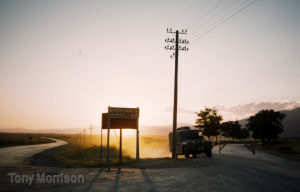 | ||||||||
| September 8th 1960 near Komotini - Greece - going non-stop to Istanbul. | |||||||||
We made few stops and often drove until after nightfall when we drew off the road and camped. We crossed the Bosphorus to Asia by ferry as the bridges of today were just dreams and in Anatolia we met the first of many bad roads. The roads became progessively worse but we maintained the pace because we were were concerned that the roads further east could be really slow. Most of the way the roads were consolidated dirt and with use they had become 'washboards - or corrugated' . At low speeds 30 - 40 kmph the pounding of tyres and suspension resonated through the vehicles. The 'barrier' was about 70/80 kmph and above that speed the driving was smooth - the danger came with sudden or abrupt faults in the road such as gullies washed out by floods, bridges that were entirely missing - in Afghanistan we found a 100km stretch where all the bridges had been broken or simply washed away. Any sudden braking to avoid disaster took the vehicle back through the 'barrier' | 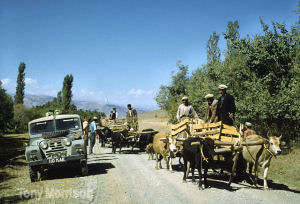 | ||||||||
| September 13th 1961 near Susheri - Turkey | |||||||||
We crossed AnatoliaTurkey via Sivas, Erzincan and Erzerum where a military escort was obligatory for 50km and photography was prohibited - we drove late each day and camped by the roadside. We crossed to Iran at Dogubayazit / Maku and headed for Tabriz, Zanjan and Teheran. Teheran was our first service stop and Mark checked the Gipsies from top to bottom. All nuts were tightened, air filters and oil were changed and the cars were greased.. We left Teheran on September 21st - we had been three weeks on the road and covered 4,300 miles. We headed east to Semnan, then across the northern part of the desert, Dasht-e-Kavin to Neyshabur and were nearing Mashad on 24th September when a stone thrown up from the road wedged betweeen the blades of the cooling fan and the radiator of the lead car. The radiator emptied in seconds and the only way forward was a tow to Mashad. Immediately we arrived in Mashad a telegram was sent to an agent in Tehran and a replacement radiator was sent by truck. We left Mashad on September 29th and within hours had another major breakdown - this was one of the rubber suspension parts of the lead car. It took a day for Mark to make the repair at the roadside and on 30th September we crossed into Afghanistan where we headed for Herat. We were one month into the journey. | 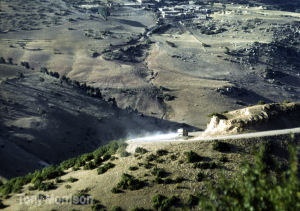 | ||||||||
| September 14th 1961 in the mountains of Anatolia after Zara - Turkey | |||||||||
| As we approached Afghanistan we had been advised to use the 'southern' route'. Several reports suggested that the northern roads were bad and across the centre of the country we could face danger from warring local tribes. The southern route took us through Farah, to Gereshk - across the Helmand River where work was in progress for the Helmand River Scheme [a dam was built across the river in 1953 and irrigation was the next step] - then on to Kandahar [Quandahar] where the road turns northeast to Ghazni and Kabol. Our stop in the capital was brief and our route to Jalabad led through the Tangi Garu ravine on a new road built with Russian help. | 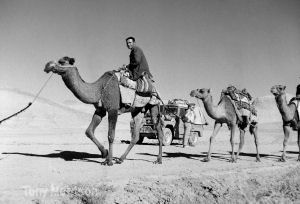 | ||||||||
| October 1960 - southern Afghanistan | |||||||||
We crossed to Pakistan at the Khyber pass. Then via Peshawar and Rawalpindi to Lahore on 7th October where again it was time for a major service for both vehicles - courtesy the Austin agent. India was the next stop and we left Lahore on 9th October. By changing drivers we maintained a good daily average and stopped only at Amritsar to visit the Golden Temple and Delhi for a diplomatic visit to the British High Commission to say we had arrived. Then it was onwards to Agra , Indore - for some new tyres, and finally Bombay [Mumbai] reached by an overnight drive to avoid the heat. We arrived at midday on Saturday 16th October 1960. |  | ||||||||
| October 1960 The Khyber Pass - Pakistan | |||||||||
Our destination in India was near Satara a full day's driving southeast from Bombay [Mumbai]. We were to be based in Pusegaon a village of about 2,500 people with connections to two small towns Aundh and Koregaon. There is a map, some photgraphs and a report of a follow-up Reunion in 2000. See Pusegaon - A Village in India We arrived in Pusgaon at the end of October 1960 and left Koregaon on January 2nd 1961. Our route took us directly south through Bangalore, Ootacamund, [ now Udhagamandalam] in the Nilgiri Hills to Mandapam where we took the ferry to Sri Lanka to arrive in Colombo on 13th January 1961. | 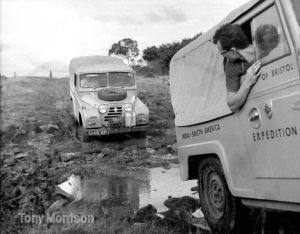 | ||||||||
| November 1960 - between Pusagaon and Aundh - Maharashtra, India - almost a daily journey | |||||||||
By sea Colombo , Sri Lanka- 18th January 1961 via Singapore, Australia - Melbourne and Sydney to New Zealand [Wellington] By courtesy of the Dutch steamship company Royal Rotterdam Lloyd on the MS Willem Ruys making a regular around the world journey. The ship was later sold and renamed Achille Lauro and is remembered in maritime history for the hijack by PLF [Palestine Liberation Front] in 1985. The Willem Ruys took us as far as far as Callao the port for Lima, Peru where we landed the two Gipsies on 19th February 1961. Also on board we had crates of supplies and spares packed in England and despatched with the ship from Europe. | 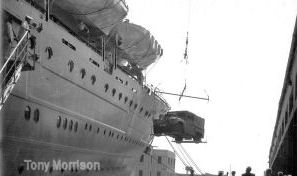 | ||||||||
| 19th February 1961 - Unloading at Callao, Lima, Peru after the Pacific crossing | |||||||||
By road through Peru to Bolivia. The route took us south from Lima southwards to Arequipa. Then then after a climb into the Andes mountains the road followed the western and southern shores of Lake Titicaca to La Paz the capital of Bolivia. La Paz became our base and we travelled to the main provincial centres including Santa Cruz in the eastern lowlands. Once the Project work was completed in Bolivia we went northwards through Peru via Cusco back to Lima. From Lima we used the coastal Pan American Highway via Trujillo and Tumbes to Ecuador. We called at Quito the Ecuadorian capital and continued north to Tulcan where we crossed into Colombia. Our destination was the Atlantic port of Barranquilla. | 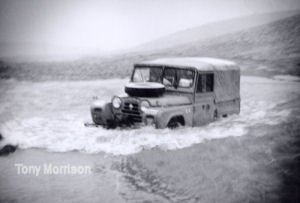 | ||||||||
| Late February 1961 - Fording an Andean stream in the rainy season between Arequipa and Juliaca, Peru | |||||||||
| By air cargo Before setting out from Bristol we knew our Expedition was not equipped to cross sthe swampy, forested 'Darien Gap' the break in the Panamerican Highway between northwestern Colombia and southern Panama. So we had booked space on a coastal sea freighter to take us from Colombia to Central America. We arrived in Colombia to discover the freighter was not on schedule and as our time was limited we took a very convenient 'lift' - hitch hike style in a cargo flight to Miami. |  | ||||||||
| July 1961 - Loading at Barranquilla, Colombia | |||||||||
| By road We left Florida for New Orleans and then northwards through the USA and Canada. 'In the north of the United States and in Canada (principally Ontario) we carried out our task of municpal diplomacy, delivering letters and goods wishes from the Lord Mayor of Bristol to the Mayors and Citizens of many cities and townships.' | 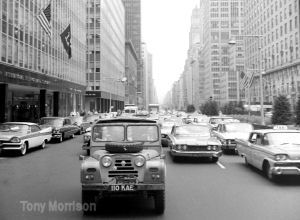 | ||||||||
| August 1961 - New York, USA | |||||||||
The return to Bristol across the Atlantic ocean was from Baltimore USA on a cargo ship the SS Gloucester City with accommodation for a few passengers. Our passages were provided gratis courtesy of Charles Hill and Sons a long established Bristol shipping line. When we passed the Fastnet Light off the southern coast of Ireland we knew we were about to complete the ' Full Circle' . We arrived in Avonmouth on September 28th 1961. We were met at the dockside by the Lord Mayor of Bristol, other supporters, family members and friends. Once again the Police escorted us and we drove to the University Union building, the Victoria Rooms. Then back in the office we relaxed-it was much as we had left it - maps - route planners -filing cabinets..The epic journey was over. | 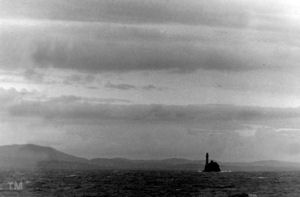 | ||||||||
| Fastnet and landfall | |||||||||
Mark Howell kept logs for the two vehicles noting mechanical faults, tyre changes fuel and more. Here is the log for 110KAE the Gipsy driven by Mark, Don Pilton and Tony Morrison. A separate log was kept for the vehicle driven by Malcolm McKernan, Roger Tutt and Peter Krinks. It is kept in the Collection | |||||||||
| |||||||||

